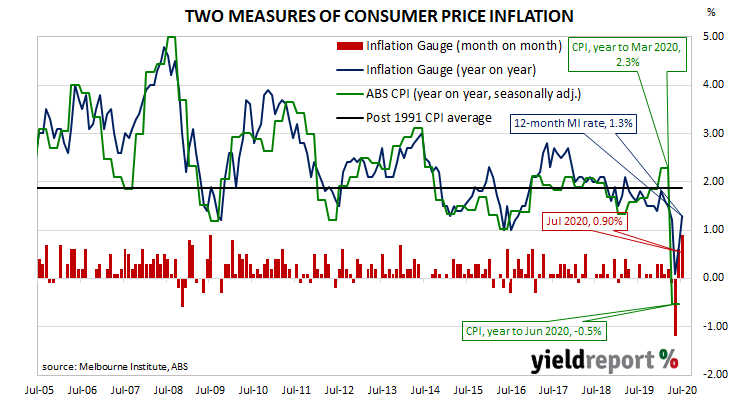Summary: Melbourne Institute inflation index jumps; second consecutive month of strong rises following plunge in May; annual rate increases, back above 1%.
Despite the RBA’s desire for a higher inflation rate, ostensibly to combat recessions, attempts to accelerate inflation through record-low interest rates have failed to date. The RBA’s stated objective is to achieve an inflation rate of between 2% and 3%, “on average, over time.” Since the GFC, Australia’s inflation rate has been trending lower and lower and the “coronavirus recession” crushed it.
The Melbourne Institute’s latest Inflation Gauge index jumped by 0.9% through July. The increase follows a 0.7% increase in June and a 1.2% drop in May. On an annual basis, the index increased by 1.3%, a significant acceleration from May’s comparable rate of 0.7%.
Long-term Commonwealth bond yields moved noticeably higher, ignoring lower US Treasury yields in overnight trading. By the end of the day, 10-year and 20-year ACGB yield both finished 5bps higher at 0.88% and 1.46% respectively. The 3-year yield remained unchanged at 0.30%, 5bps above the RBA’s target.
The Melbourne Institute’s Inflation Gauge is an attempt to replicate the ABS consumer price index (CPI) on a monthly basis. It has turned out to be a reliable leading indicator of the CPI, although there are periods in which the Inflation Gauge and the CPI have diverged for as long as twelve months. On average, the Inflation Gauge’s annual rate tends to overestimate the ABS headline rate by an average of a little under 0.1%.
Central bankers desire a certain level of inflation which is “sufficiently low that it does not materially distort economic decisions in the community” but high enough so it does not constrain “a central bank’s ability to combat recessions.” Hence the obsession among central bankers to increase inflation.

